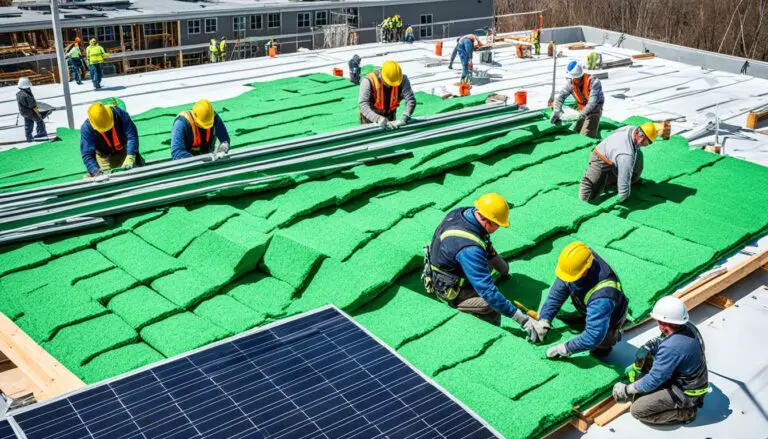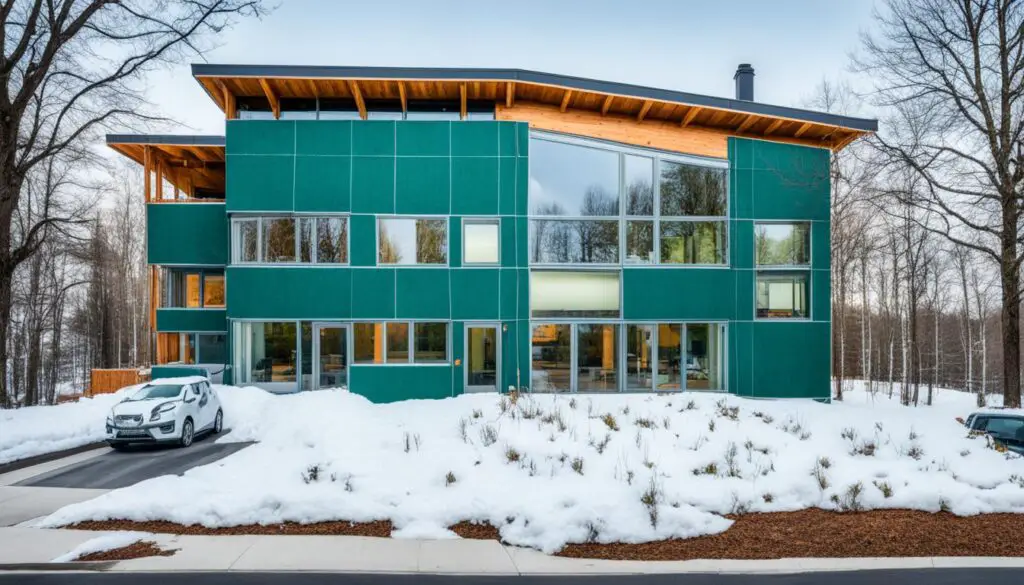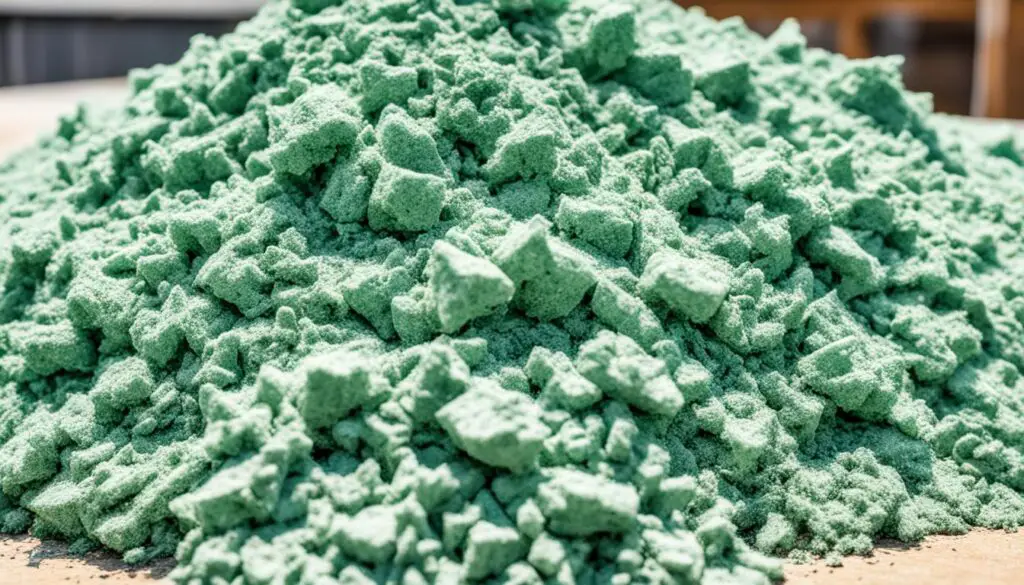Building a sustainable future is vital. This includes using green insulation materials. These eco-friendly options are transforming the way we build. They provide sustainable, energy-efficient solutions. Let’s explore the world of green insulation materials!
Key Takeaways:
- Green insulation materials offer sustainable and energy-efficient solutions for construction.
- Recycled insulation and reused insulation are two types of green insulation materials.
- Architects, builders, and individuals can support the sustainable future by choosing recycled or reused insulation.
- Green insulation materials help reduce environmental costs by conserving resources and improving energy efficiency.
- By embracing sustainable insulation, we can contribute to a greener future and a more sustainable built environment.
The Environmental Impact of Green Insulation Materials
Traditional building materials take a toll on our planet. The extraction and processing of raw materials, like timber and concrete, hurt our forests and increase greenhouse gases. These activities use a lot of energy and create carbon emissions.
Green insulation materials offer a brighter future. They are made from recycled or reused resources. This helps lower the construction industry’s environmental impact. These materials also help save resources and cut down on waste.
Green insulation materials are great for keeping buildings warm or cool. They fill in gaps and stop heat from escaping or entering. This reduces the need for heating or cooling. It saves energy and cuts carbon emissions. Homeowners can also enjoy lower utility bills.
Choosing green insulation materials is a win for everyone. We cut down on environmental harm and create buildings that use less energy.
Using recycled insulation is a major step towards sustainable building. Architects, builders, and homeowners all play a part in this change. By picking green materials, they help secure a greener future.
Let’s look at some new, sustainable insulation options. These choices help make buildings that are eco-friendly and energy-efficient.
Innovations in Sustainable Insulation
There are many sustainable insulation choices each with special benefits. Here are some popular ones:
- Cellulose Insulation: Made from recycled paper, it’s renewable and effective. It reduces the need for non-renewable resources.
- Natural Fiber Insulation: Materials like hemp make natural fiber insulation. It not only insulates but also uses renewable resources.
- Recycled Insulation: This includes repurposed materials like glass bottles. It’s great for energy efficiency and cutting down virgin material use.
- Aerogel Insulation: This material is mostly air but highly efficient. It traps heat well, making it excellent for insulation.
These options give architects and builders flexibility in their green projects. Using them means creating buildings that are good for our future.
In our next section, we’ll see how these materials lead to buildings that use no extra energy.
Innovations in Sustainable Insulation
Today, the market offers several innovative options for sustainable insulation. These new materials give architects and builders eco-friendly ways to make buildings more energy-efficient. Let’s look at some leading innovations in sustainable insulation.
Cellulose Insulation
Cellulose insulation is a top renewable and energy-saving choice. It’s made from recycled paper and traps air well. This not only makes it sustainable but also adds great fire safety.
Natural Fiber Insulation
Natural fiber insulation uses hemp or cotton. These materials provide strong thermal insulation and use less non-renewable resources. Their production is also less harmful to the environment than traditional materials.
Recycled Insulation
Recycled insulation turns waste like glass bottles or newspapers into useful insulation. It keeps waste out of landfills and lessens environmental harm. Plus, it’s an affordable, green option.
Aerogel Insulation
Aerogel insulation is super light and mostly air, yet it’s very effective. It’s easy to install and stores heat well, saving energy. It’s perfect for tight spaces needing top-notch insulation.
To sum up, sustainable insulation options like cellulose, natural fiber, recycled, and aerogel insulation give builders many choices for green, efficient buildings. Using these materials helps build a better, more sustainable world.
| Insulation Type | Key Features |
|---|---|
| Cellulose Insulation | Made from recycled paper fibers Renewable and energy-efficient Excellent fire-retardant properties |
| Natural Fiber Insulation | Hemp or cotton-based Provides thermal insulation properties Reduces reliance on non-renewable resources |
| Recycled Insulation | Utilizes waste materials Repurposes glass bottles or newspapers Effective thermal performance |
| Aerogel Insulation | Ultra-lightweight and highly efficient Composed mostly of air Exceptional thermal insulation properties |
Conclusion
Sustainable insulation changes the game in eco-friendly building. It uses materials like cellulose, natural fibers, and recycled stuff. This helps our planet.
Environmentally friendly insulation improves energy use and lowers carbon footprints. It also helps in saving resources.
Choosing green insulation brings many benefits. It can lower your energy bills and make your home cozy. It’s good for you and the planet.
Green buildings show what’s possible with sustainable insulation. They inspire everyone to build in an eco-friendly way.
By using sustainable insulation, we work towards a greener future. It makes buildings better for the environment. We need to spread the word to make a big change.
This helps us get closer to having buildings that use zero net energy. Together, we can make a lasting difference for the future.
FAQ
What are green insulation materials?
How do recycled insulation and reused insulation differ?
What are the environmental benefits of green insulation materials?
What types of sustainable insulation are available in the market?
What advantages does sustainable insulation offer?
How can architects, builders, and homeowners contribute to eco-friendly construction?
Source Links
- https://www.getvergo.com/post/staying-green-innovations-in-sustainable-insulation-for-eco-friendly-construction
- https://www.linkedin.com/pulse/how-cellulose-insulation-revolutionizing-green-building-designs
- https://greeninsulationgroup.com/building-green-the-rise-of-a-sustainable-insulation-revolution/



